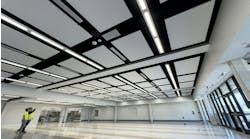Latest from Technology
Sponsored
AI and Digital Twins: The Key to Scaling Digital Transformation in Plumbing
Digital transformation is key to success in almost any sector today. Still, many organizations in more industrial sectors, like plumbing, have faced difficulty implementing and scaling their Industry 4.0 projects.
One of the primary challenges in succeeding in digital transformation is a lack of focus. Prioritizing the most impactful technologies—namely, artificial intelligence (AI) and digital twins—can help plumbing contractors overcome these barriers and see greater results.
How AI and Digital Twins Improve Plumbing Operations
Capitalizing on any technology starts with recognizing where it can drive value. With that in mind, here’s a closer look at the role of AI and digital twins in plumbing system optimization.
One of the most significant applications of AI in plumbing is predictive maintenance (PdM). PdM monitors pipe networks in real time through Internet of Things (IoT) sensors, using machine learning to analyze conditions for early signs of failure.
With enough data, machine learning models can predict repair issues before they occur, enabling timelier preventive care. While conventional, schedule-based maintenance technically does the same thing, it’s prone to error and causes a lot of unnecessary downtime.
PdM eliminates breakdowns and repair-related downtime to unneeded fixes. As a result, systems relying on it experience 52.7% less downtime than those using reactive maintenance and 18.5% less than those using traditional preventive care.
Streamlined Infrastructure Management
AI and digital twin technology also make it easier to manage water systems outside of maintenance. Digital twins of a pipe network can reflect how a facility uses water over time. Inefficiencies and potential strategies to address them become more identifiable as a result.
Digital twins are more than just a virtual mock-up. Their connection to real-world data through IoT sensors means they react and evolve to new situations the same way the real system does, making them a valuable simulation tool. Plumbers can simulate various changes or possible conditions in the twin to identify effective optimization strategies or highlight risks.
Plumbers can also use digital twins to inform more efficient building automation. Automated utilities responding to real-time data could cut 90% of building emissions by 2050, thanks to their waste elimination.
Improved Building Information Modeling
AI data analytics can even bring value to plumbing systems before a structure is complete. Many construction firms already use building information modeling (BIM) to plan their projects, and AI functionality takes this technology further. AI-enabled BIM can inspect the virtual model for flaws or inefficiencies to highlight how water network redesigns could prevent real-world issues.
Ensuring a plumbing system is less prone to obstruction or maintenance problems from the start greatly reduces future costs and complications. However, it’s difficult to account for all possibilities when using manual designs and tests. AI can analyze BIM models to simulate potential events and increase confidence in a design’s real-world value.
These Industry 4.0 technologies can also address the industry’s workforce concerns. A staggering 87% of contractors today say it’s difficult to find skilled workers. While AI and digital twins cannot automate physical tasks to reduce the need for employees, they can open the door to a broader talent pool.
Recruits can use digital twins to simulate various plumbing situations to gain relevant experience without encountering real-world issues. AI can parse job websites and resumes to find potential candidates who may lack direct experience but have needed soft skills. As a result, it becomes easier to foster talent instead of seeking those with existing skills, leading to faster role-filling.
Challenges in Applying AI and Digital Twins in Plumbing
As beneficial as AI and digital twins are, successful integration of technologies is often challenging. Like any other Industry 4.0 innovation, these systems can introduce new complications that, if unaccounted for, may counteract their advantages.
Costs are the first obstacle many contractors encounter. While digital twins and AI can reduce operating expenses over time, they often require a significant upfront investment. In light of how the plumbing industry’s annual growth may slow from 2.5% to below 1% in the coming years, some businesses may be unable to justify the spending.
AI and digital twins are also easy to get wrong. Both require careful attention and optimization to deliver their full value. A lack of experience with digital technologies and a rush to implement them often limit returns on investment (ROIs) as a result.
Similarly, many contractors are unsure of where or how to use these plumbing innovations. This lack of direction and failure to tie tech investments to real business needs hinders digital transformation efforts.
Scaling Digital Transformation
Successful scaling of digital transformation with AI and digital twins means paying attention to the benefits and downsides of these technologies. Plumbers can make the most of the opportunity by following a few best practices.
Given the costs and complexity of AI and digital twins, plumbing professionals must avoid the trap of adoption for adoption’s sake. Three of the five biggest reasons AI projects fail are related to misuse and misunderstanding. A positive ROI is only possible when plumbers use tech as a solution to an existing problem—one that is relevant to the technology’s potential use cases.
It begins with recognizing where the innovation is most useful. AI is best where there’s an abundance of data and tasks requiring complex analysis. Digital twins excel when replicating complicated real-world systems that would be difficult to manage otherwise.
Contractors without the necessary data or whose current problems don’t align with these technologies’ strengths may need to hold off on investment for now. Unnecessary disruption is likely to produce more problems than answers.
Similarly, plumbing organizations must retrain themselves when implementing Industry 4.0 technologies. It may be tempting to apply tech wherever possible to maximize its impact, but this will lead to astronomical costs and troubleshooting difficulties.
Instead, it’s best to focus on one use case at a time. Begin with the application that stands to gain the most from digital twins or AI. Only scale up to other tasks and projects after the initial rollout shows a positive return and employees have learned how to use the technology well.
Don’t Overlook Workforce Considerations
Plumbing professionals should also recognize the need for training and preparation to use AI and digital twins effectively. A lack of relevant talent is the most significant barrier to tech adoption in many companies, but plumbers can work around it by fostering skills from within.
Take AI and other IT-related courses to learn the ins and outs of the innovation. Offer upskilling opportunities to employees to promote greater tech literacy. Encourage communication when adjusting workflows according to new technologies. While steps like these may seem insignificant, they ensure the workforce can apply digital twins and AI with less trial and error, leading to better returns.
Digital Twins and AI Are Key to Digital Transformation
Digital transformation in plumbing can be difficult. Focusing on AI and digital twins above other innovations is a good start, but professionals must also recognize that these technologies require a careful approach.
Learning the benefits and challenges of Industry 4.0 solutions will make it easier to maximize their value. Doing so will prove key to maintaining growth in the future.

Rose Morrison
Rose Morrison is a freelance writer who covers construction, home improvement, and contracting topics. She is also the managing editor of Renovated.com, a site dedicated to the latest trends in the home industry. She has a passion for innovative technologies that are making the home industry sustainable and efficient. Check out Renovated.com to see more of her work.


